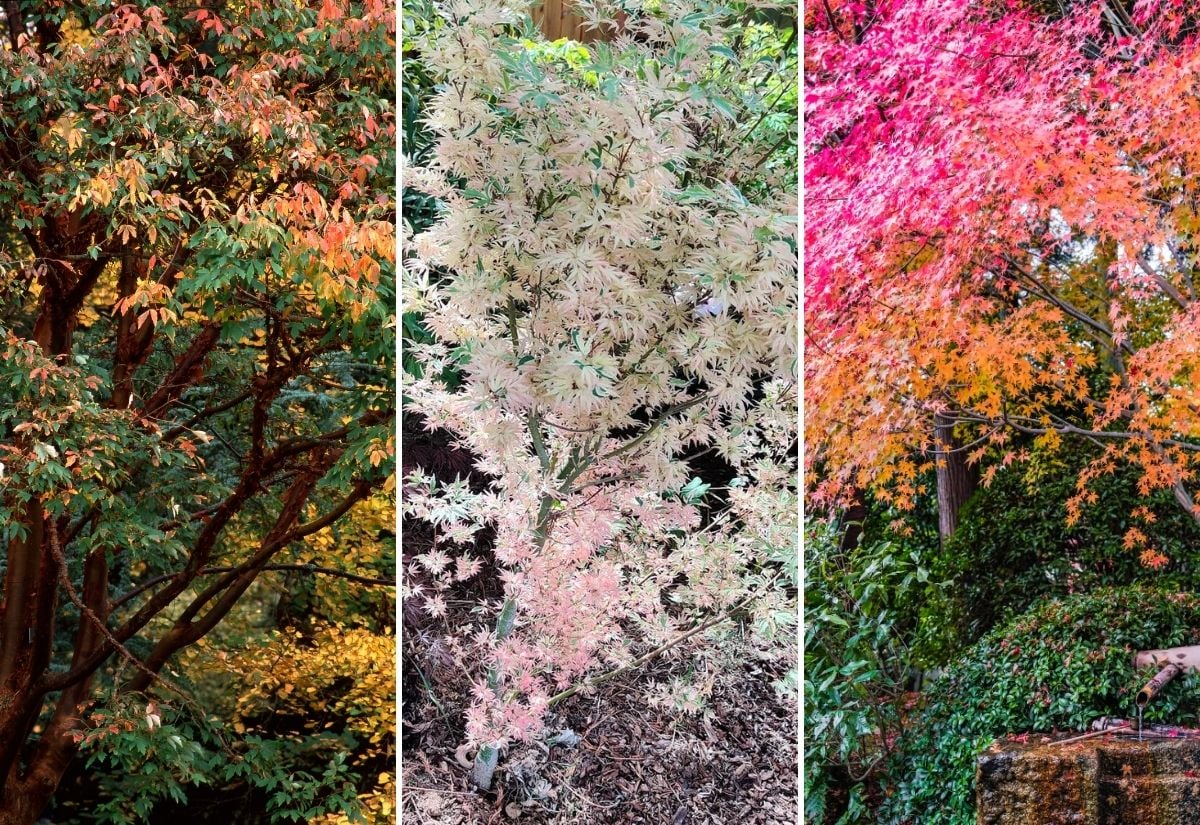
Big or small, the maple trees, with its unparalleled elegance and the incomparable splendor of their autumn coloring, irresistibly attracts the eye and everyone falls under its spell.
Known for their original palmate deciduous foliage, which is often red or changes colors through the year, the oriental look of some species, original winged fruits that twist in the wind, maple presents itself as one of the most beautiful trees of autumn.
From the filigree small shrub to the mighty large tree, maple trees size varies from from 148 feet tall (45 meters) to less than 10 feet (3.0 meters), all with very strong, sometimes even statuesque personalities.
And you too can have their oriental or temperate look in your garden, choosing from the many North American European or Asian species, or the even more numerous cultivars with amazing qualities!
Maple trees are plants of the genus Acer, which comprises 132 species from the Northern Hemisphere and more than 1,000 cultivars! It’s one of the most popular garden trees all over the world, and you can recognize maple trees by their webbed leaves, with splendid fall colors and sometimes by their bark.
Of varied appearance, maples can be used as a windbreak or free hedge, in clumps, as isolated subjects or even in pots, or even as bonsai.
Immerse yourself in a hand-picked selection of the most beautiful types of maple trees and and how to tell them apart.
By the end of this article you will be able to identify each and every single one; but maybe we should start with telling a maple from an other tree genus, like a plane tree or a linden?
How You Can Identify A Tree Of The Maple Genus
Let’s see how you can tell that what you have in front of you is a member of the Acer genus, and not some other plant that shares some traits. And you need to look at two or three characteristics together. Let me explain…
I mentioned plane trees on purpose before, why? The leaves can be confused with those of a pale tree by the inexperienced eye.
But then you loom at the trunk and you see that the bark of planes is flakey, smooth and “gray” (many colors actually) and you understand it can’t be a maple…
Similarly lindens too have winged fruits, though not exactly the same as samaras, but the leaves are heart shaped, so… You see what I mean?
Thus, let’s look at all the “tell tale” signs we need…
Maple Trees and Size
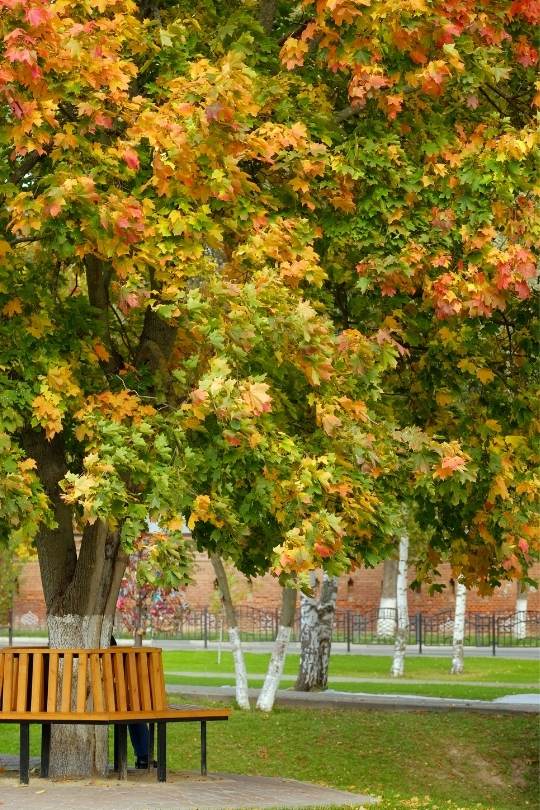
Maple trees have a large size range; some garden varieties are really short, while others are huge.
But this on its own can exclude some trees, like plane trees in fact, which are colossal, but it is better as an identification tool between different Acer species and varieties than with other trees.
Recognize a Maple Tree Leaf
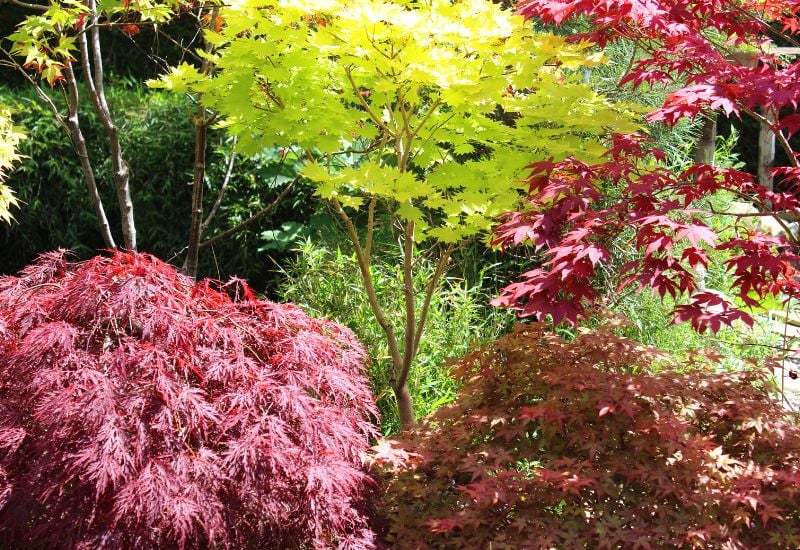
Foliage is the first element to look at with maples. Leaves are clearly palmate. This means that they have the “shape of a hand”, with 5 or 3 main parts joined in the middle. The edges have points, and the lobes can vary un depth.
If you look close, you can clearly see straight ribs that go from the center to the tips of the “fingers”, and secondary ribs too. These keep the leaf sturdy and in shape against wind and weather. The margins can be smooth or serrated.
Filigree leaves of maple trees are very variable in shape and color, turning bright yellow-orange to crimson in autumn and often adorning themselves with special shades of color in spring when they are sprouting.
The leaves are never fuzzy, and they are thin, in some cases, you can partly see through them. But maybe the easiest way to tell a maple leaf is to look at the Canadian flag, because it is the symbol of Canada.
Recognize Maple By It’s Flowers
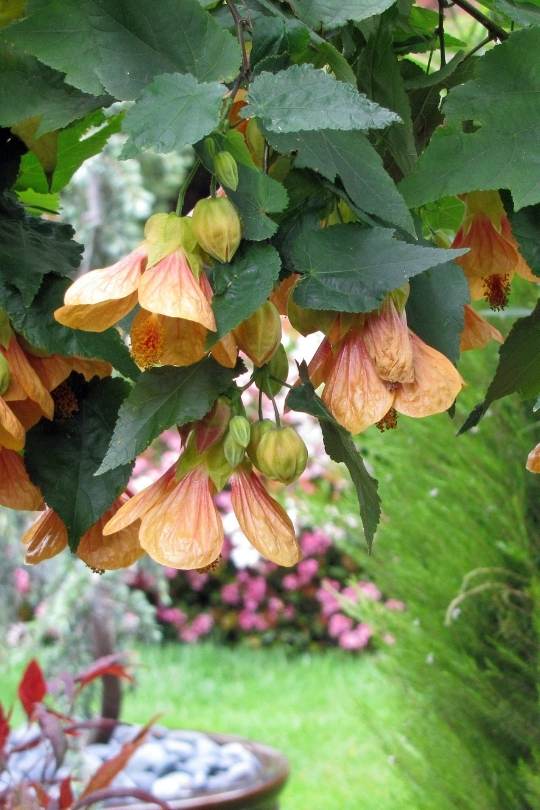
Maples are flowering trees, but… The blooms are small and inconspicuous. They come in clusters with long petioles and tiny blossoms that can be yellow, green or red. They usually appear on the branches in spring, when the new leaves are just coming.
The flowers are not a good way to identify the genus and the varieties within it for many reasons; they are seasonal, not permanent and very easy to confuse. Let’s leave it to botanists.
How to Identify Maple Fruits (Samaras)
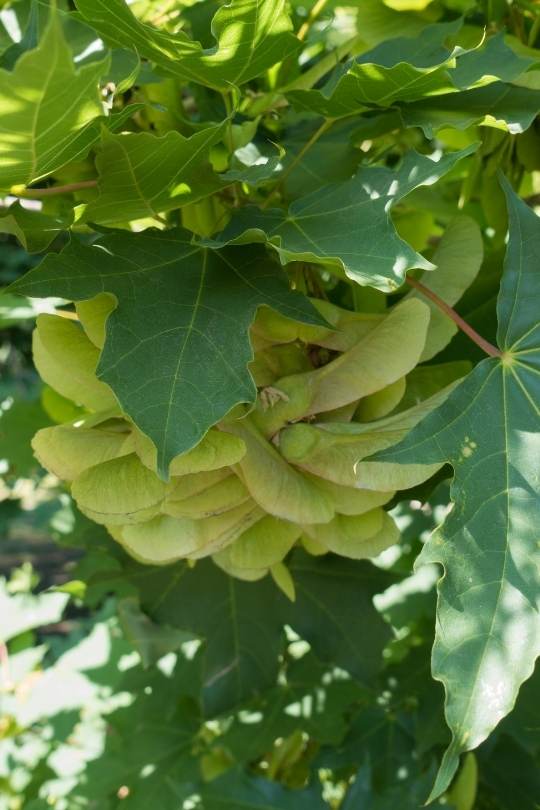
Flowers give way to very original fruits, which are called “winged fruits”, “helicopters”, “maple keys” “whirly birds” “polynoses” or technically “samaras”. They are very easy to identify…
They come in pairs, each pair is attached to the branch with a petiole. The central part looks like a small seed, it is oval and bulging. Then there is a wing with a waxy texture when they are fresh, one for each fruit. If you snap them, they will break in the middle.
The colors can vary, with green orange, brown and red being common. But when the fruit ripens and it’s ready to go, the samaras lose moisture and dry up; they usually become light brown and the wings become thin and papery.
And… if you throw them in the air they twist as they fall, like helicopter wings! I used to have lots of fun with them as a child, and I am sure yours will too if you grow one in your garden!
How to Identify Maple Bark
Maples have a cracked bark, with overall horizontal lines; you can easily rip it off. The color may change; from brown gray to reddish gray.
There are some exceptions though, like silver maple (Acer saccharinum) which has a light gray and thinly cracked bark, almost flakey, and red maple (Acer rubrum) with a dark brown bark.
How to Identify the Habit of a Maple
Maples have a range of habits, but they usually are fairly light and slightly open, less dense and thick than other trees.
Some are upright and egg shaped or oval, some pyramidal, and others have a more spreading and even arching habit, especially oriental varieties. The habit is a good identification sign to tell maples apart, rather than to distinguish a maple from another genus.
Which Elements You Should Use to Identify a Maple Tree or Tell Them Apart
“All,” would be the quick answer, but really I would suggest you focus on leaf shape and fruit shape, and use the bark look and texture in case you are still undecided.
Of course, to tell varieties apart you will need to use more traits, like the size and habit, leaf color etc.
You now have a “full toolkit” for identification, let’s spend a few words on the uses of maple trees.
The Uses Of Maple Trees
Maple trees are very useful to Humans… We grow them for many reasons, not just for gardening. For example, we all know maple syrup, which is produced by boiling the sap of sugar maple (Acer saccharum) and it’s delicious indeed, as well as a traditional and popular Canadian product.
Larger maple trees are also grown for timber, in particular sugar maple (Acer saccharum) in North America and sycamore maple (Acer pseudoplatanum) in Europe.
But it is also used as tonewood, which means that it’s used for musical instruments. In fact, the necks of most strings like violins, violas, cellos and double basses, as well as of electric guitars, is made of acer wood!
But what we are really interested in is how to use maple trees in gardening…
The Use of Maple Trees in Gardening
Maples are very important in gardening; their elegance is one factor, but not the only one.
The leaves are decorative, original and interesting, but they also have a range of colors, from species to species but often through the year. In fact, many maple tress turn yellow and then red in fall.
While you also have many varieties with bright red or even purple foliage throughout the year! You can imagine how sought after this is to give an eye catching twist to foundation planting, or to the “green” of a garden in general.
The samaras are interesting and playful; this is an element that adds a point of interest to our trees.
Some maple trees are very small, the famous Japanese maple (Acer palmatum) being a primary example. Needless to say a small tree is a great asset for a small garden! So, they have found their way into small suburban and urban gardens, and even onto terraces and in containers!
Some maples have a very elegant habit, especially Asian varieties, that can have spreading, open, even arching habits; they bring the look and feel of Chinese or Japanese gardens like few other trees can!
Last, but not least, maple trees are used for bonsai! This follows from their size and habit especially, or at least of some of them…
I am sure you will find a use for a big or small maple tree for your own green space, and this is why I want to suggest a few to you; to train to identify them, but also to pick one…
12 Types of Maple Trees To Add Tons of Color to Your Landscape
Maple trees are extremely decorative and popular garden trees because of their variety. In addition to splendid coloration in autumn, the picturesque growth habit and the beautiful bark markings of some variants are very ornamental, depending on the species.
We have collected the best maples for identification of large and natural species and the most beautiful cultivars for your garden.
Here are 12 most beautiful types of maple trees Identified For You!
1. Sugar Maple (Acer saccharum)
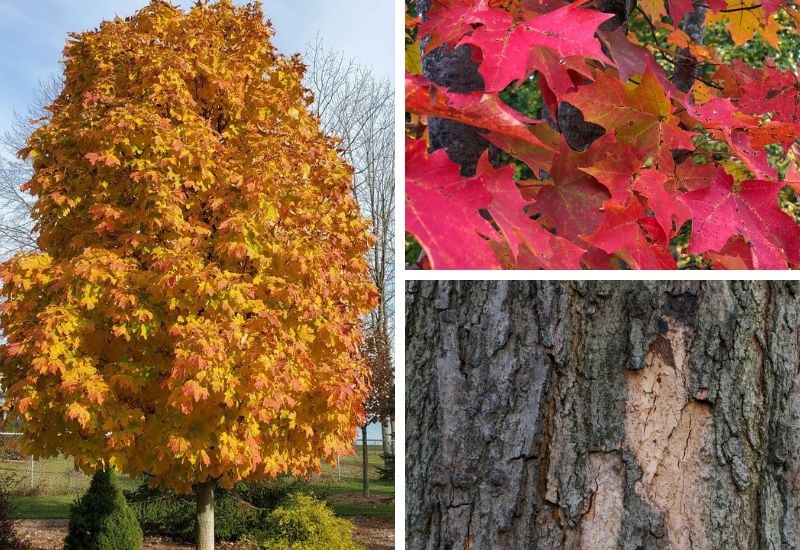
The famous sugar maple is a native species of North America and the symbol of Canada. It has an upright habit, with an oval or round crown and branches that start sideways and often curve like elbows and point up.
The leaves are five lobed, dark green in summer but then yellow, orange and red in fall, about 3 to 6 inches across (7.5 to 15 cm). It has gray brown bark and it is a big tree. This is the variety we use to make syrup, but it takes 40 liters of sap to make a single liter of syrup.
Sugar maple is long lived and ideal for specimen and foundation planting; it is well suited for temperate regions with cold winters and it is of interest all year round, but it requires a big garden.
2. Norway Maple (Acer platanoides)
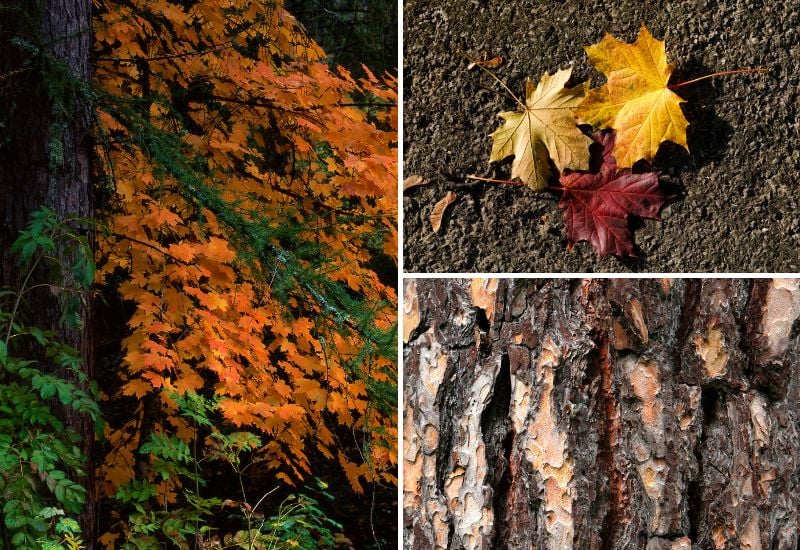
Norway maple has a thin trunk with gray and finely cracked bark and branches that tend to the sky. The crown is round and dense, unlike other varieties.
The leaves are large, up to 7 inches across (18 cm), with five lobes and very pointed. They start off copper and light green, a shade which they keep till the end of summer, then they explode into a range of warm colors, from yellow to dark purple.
Norway maple is a spectacular tree for specimen and foundation planting in temperate gardens; the longer fall is, the more extended the end of year show of this tree, which is large, and it wants a spacious garden.
3. Red Maple (Acer rubrum)
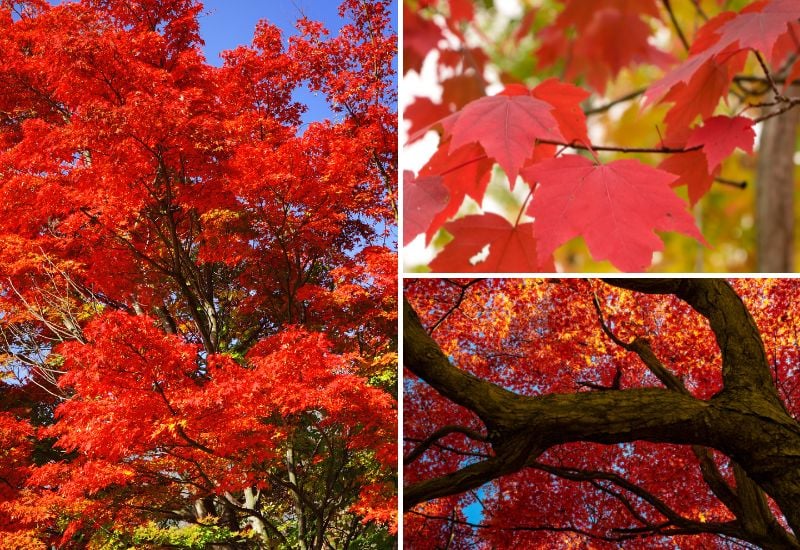
Red maple is so easy to identify: its leaves are red in spring, then they turn dark green with off white undersides in summer and then again yellow and finally red again before they fall. They are serrated and in contrast with the gray bark on the upright trunk and up turned branches.
The overall shape of the crown is pyramidal, unlike the varieties we have seen so far, but only when it’s young… As it ages, it turns to round. You got the point, this maple tree keeps changing all the time…
Red maple is ideal for specimen planting and foundation planting in sizable gardens; its color display is unique and dynamic, and it looks great in contrast to the green of a well kept lawn or green and blue foliage of other trees.
4. Paperbark Maple (Acer griseum)
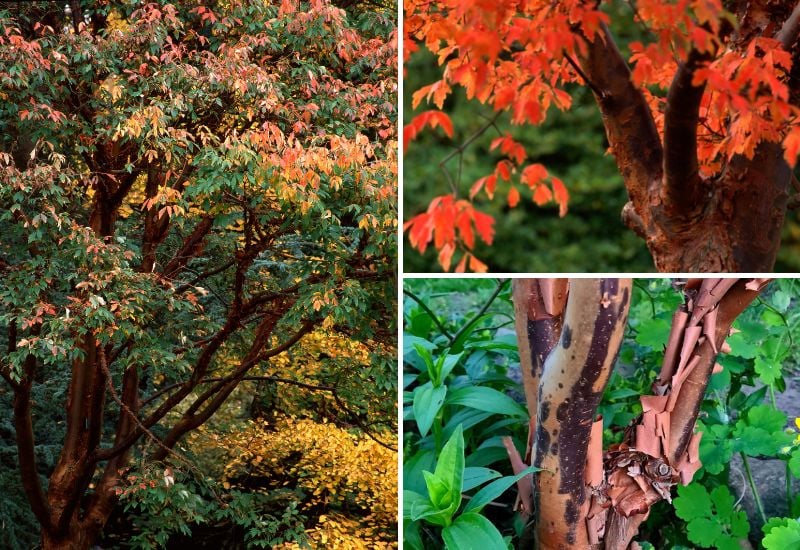
Paperback maple is an extraordinary tree for gardens, assent identify. The name comes from its unique chestnut brown to red smooth and peeling bark.
The trunk is short with spreading, outward branches that have clouds of bright green foliage on the top. Actually this is the overall effect, because each three lobed leaf is dark green on top and blue green on the underside! And they turn yellow and red in fall.
It is a very elegant tree with an oriental look, fairly small and slow growing, like a living statue. It is a winner of the Award of Garden Merit by the Royal Horticultural Society.
Paperback maple needs to be put on show in clear view in gardens; it is too beautiful to hide it amid other trees, it looks great in Japanese gardens but also in natural looking settings and even in formal designs!
5. Florida Maple (Acer floridanum)
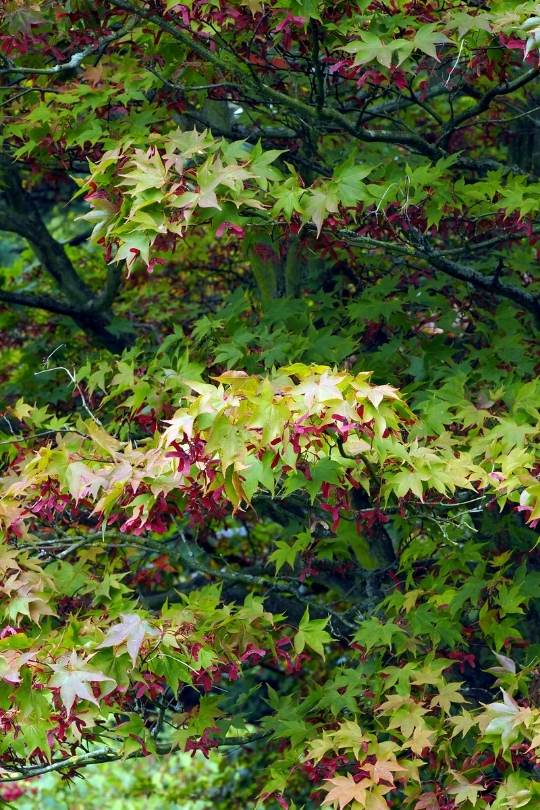
Florida maple is distinctive for its thin and upright light gray trunk and regular branches that form a pyramidal crown.
The leaves have 3 to 5 lobes, a bit rounded, and fairly small, 2 to 4 inches across (5 to 10 cm). They are dark green on top and lighter green on the underside, but they turn yellow, orange and red in fall. It is a strong and elegant tree, medium to large in size.
Florida maple will suit any informal or urban garden, including public parks and roads, you can use it as foundation planting in most settings. It is better suited for warmer regions, not cold ones.
6. Vine Maple (Acer circinatum)
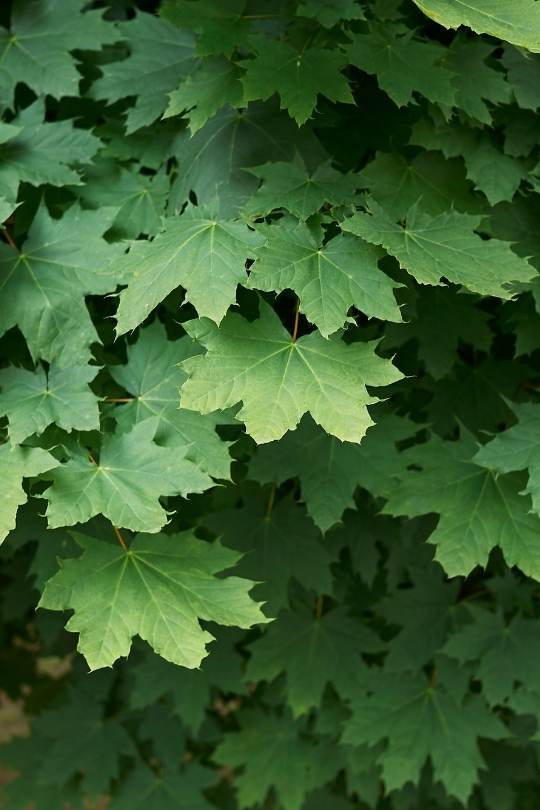
Vine maple is easy to spot; it’s not a tree, but a shrub. True, you can train it into a tree, but in Nature it will remain a bush, with low but upright dark branches and multi trunks. The foliage is broad, palmate but with shallow lobes, and it can have 7 to 9 of them.
They start off green and then they give us the usual hot color display in the late season. It is very common in the Pacific Northwest, one of the most popular plants there.
It will work perfectly well in hedges or for foundation planting; it is wild looking, so very good for a colorful display in a traditional and informal garden.
7. ‘Green Cascade’ Full Moon Maple (Acer japonicum ‘Green Cascade’)
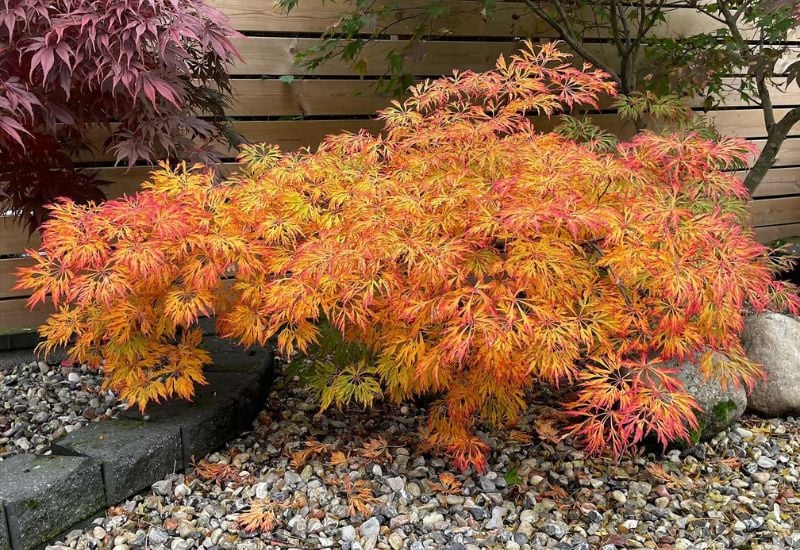
The small ‘Green Cascade’ has a weeping habit, or pendulous if you want, so it is a great cultivar maple variety for gardens. The foliage is thinly laced, very decorative and finely textured with 9 to 11 lobes. They are green but then they turn gold and even crimson as the season comes to a close.
The overall effect is very elegant with a strong “oriental touch”, and a winner of the Award of Garden Merit by the Royal Horticultural Society.
‘Green Cascade’ full moon maple is ideal for urban and suburban gardens, especially if you want both elegance and exotic together; it will look at ease un any informal setting, but especially traditional, cottage and Japanese gardens.
8. ‘Beni- Maiko’ Japanese Maple (Acer palmatum ‘Beni-Maiko’)
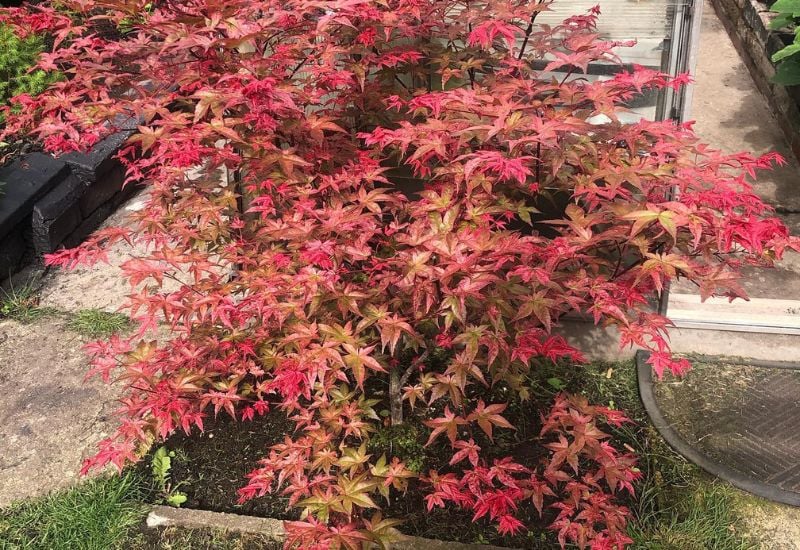
‘Beni-Maiko’ is a very small variety of Japanese maple with a red theme running through its life. The leaves always retain some of this color, but they too change over the seasons… They start off fiery red in spring and they take on some green tones away from the veins in summer.
When fall comes, they turn orange and then of the brightest red shade ever… The shades they go through are both strong and delicate, and they keep your garden alive all year round. Each leaf has five clear points with very deep lobes. It too has won the Award of Garden Merit by the Royal Horticultural Society.
Because of its diminutive size, ‘Beni-Maiko’ Japanese maple is suitable for small gardens and even large containers on terraces. It suits all informal settings, from cottage gardens to urban, gravel and, of course, Japanese designs.
9. ‘Butterfly’ Japanese Maple (Acer palmatum ‘Butterfly’)
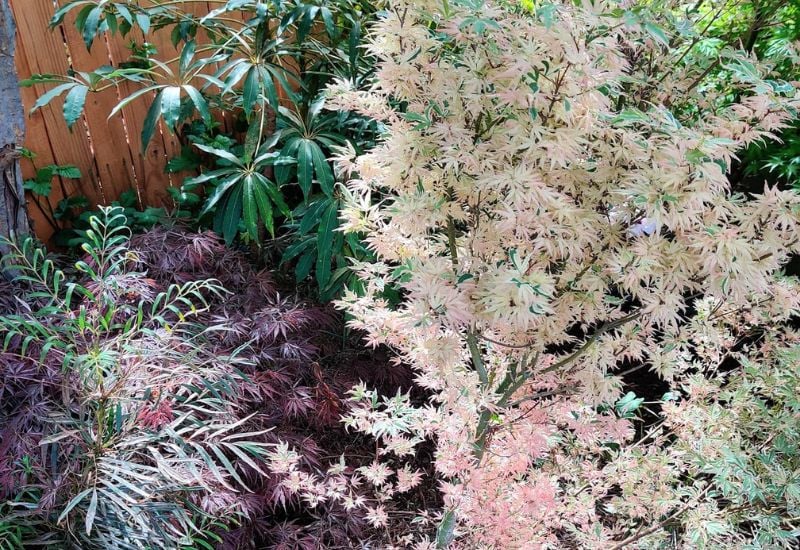
‘Buttefly’ is a medium small cultivar of Japanese maple tree with very distinctive characteristics; you can’t get this wrong… The leaves have 5 to 7 deep lobes and sometimes they twist…
But the tell tale sign is that they are variegated; light green with cream edges, and sometimes some pink shades at the margins, especially in spring.
Some leaves can be fully green but the thick foliage is a real color spectacle. In fall, they turn magenta and scarlet, like a burning fire! The texture is exceptional too, and it adds to the very elegant branching and its graceful proportions.
‘Butterfly’ is the maple tree you want for color and texture at the same time; suitable to literally any informal garden, including urban ones and those with an oriental theme, it is also small enough to fit into a container; actually, it looks amazing in a beautiful pot.
10. Garnet’ Laceleaf Japanese Maple (Acer palmatum ‘Garnet)
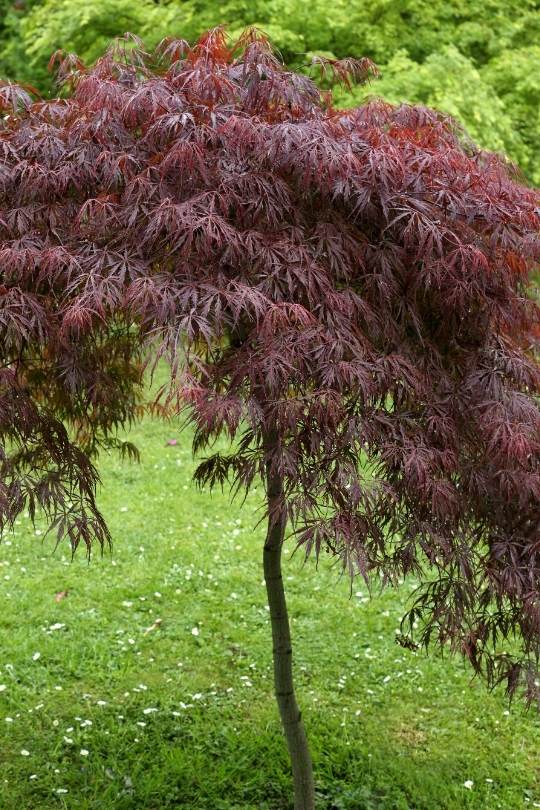
You will recognize ‘Garnet’ laceleaf Japanese maple at a glance! This shrub or small tree has very thinly laced foliage. The leaves are large overall, but they have very deep cuts and each segment is thing and serrated, with 7 lobes. The texture is delicate and breezy, like lace indeed. The color is striking too; it starts off as red orange and it turns darker and darker as the months go on, to a deep garnet shade in fall.
The branches are pendulous, ideal for very elegant and artistic garden with an oriental inspiration. It has won the Award of Garden Merit by the Royal Horticultural Society.
‘Garnet’ laceleaf maple only needs a modest green space to fit in, and a tidy but informal setting to look its best; traditional, Japanese, gravel, courtyard, urban and suburban gardens are all just fine!
11. ‘Sango-Kaku’ Coral Bark Maple (Acer palmatum ‘Sango-Kaku’)
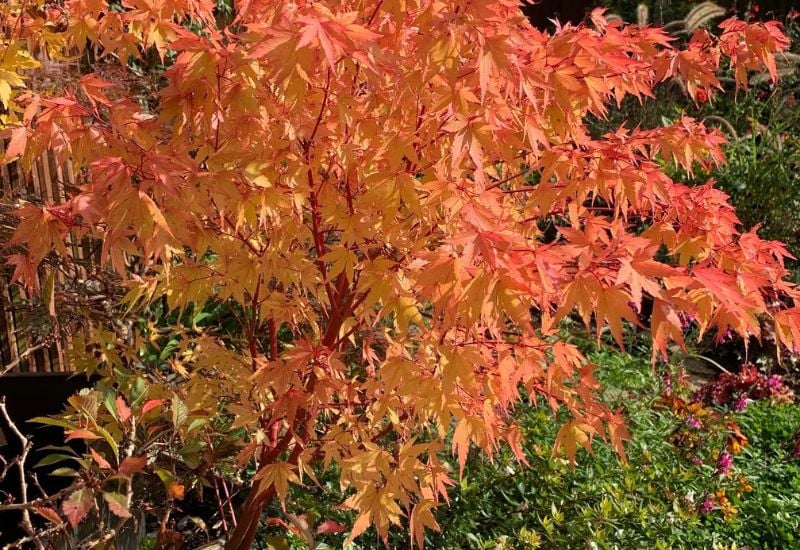
‘Sango-Kaku’ is one of those medium sized maple tress or large shrubs that fit in small gardens. But when it comes, it will make all the difference. The leaves are 5 loved and quite “canonical” for the Acer genus, but… They are yellow pink in spring, then they mature into light green during the summer months, and finally, they turn bright yellow in fall. But the color show does not end here… The branches are coral red, and they look stunning in the contrast with the foliage. And even when the tree or shrub is naked, they provide a point of fiery interest, all through winter.
This is yet another receiver of the prestigious Award of Garden Merit by the Royal Horticultural Society!
Grown as a tree or as a shrub, ‘Sango-Kaku’ is a maple that can bring drama to any garden with its strong, warm and bright but changing tints. Informal ones are better all the range from oriental to cottage gardens!
12. ‘Ukigumo’ Floating Clouds Japanese Maple (Acer palmatum ‘Ukigumo’)
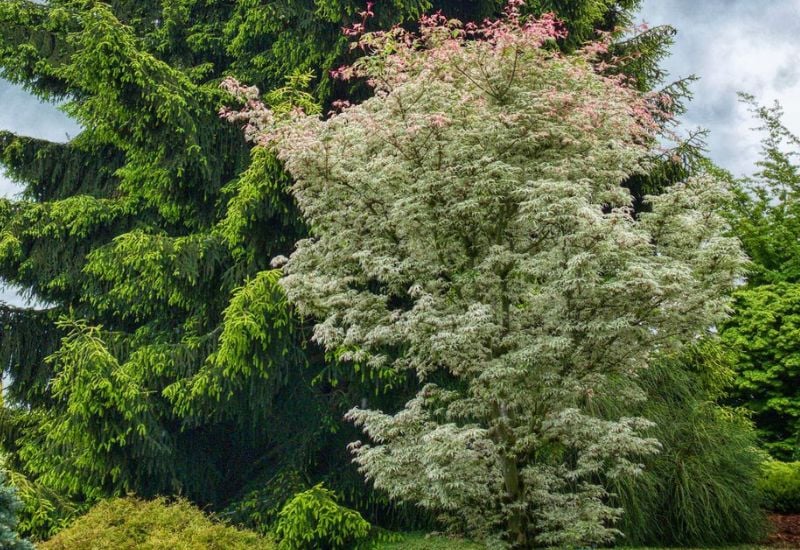
‘Ukigumo’ floating clouds Japanese maple is unusual, so easy to identify…. It is a small tree or shrub variety with variegated foliage; they are pale green with pink shades and white dashes, they have clear points at the tips and they are very deeply lobed.
They have a very light look on them, in fact like wings or clouds on the dark brown arching branches of this cultivar. The twigs are almost horizontal too. As usual, the foliage will change shade in fall, and it will become bright orange.
As a shrub, you can use ‘Ukigumo’ floating clouds Japanese maple in large borders and hedges, but as a small tree it is ideal against a green lawn in a natural looking garden, like a traditional one. But keep in mind that you can have it on terraces and patios too: just choose a large and beautiful container for it!
Now You Can Identify Maple Trees… Just Pick One!
True, there are many other species and cultivars of maples, and we can’t see them all here.
But you have met the most popular natural Acer trees from all over the world and also some of the most original, striking and decorated cultivars. You will notice that Japanese and full moon cultivars are small or medium sized, suitable for elegant gardens, where maple trees can really catch and fee the imagination…
Big varieties are more suitable for large parks, or farms… Still the colors and shapes of maple trees are a wonder of Nature, and now you have met them, if I can ask…
which one is your favorite?

Written By
Amber Noyes
Amber Noyes was born and raised in a suburban California town, San Mateo. She holds a master’s degree in horticulture from the University of California as well as a BS in Biology from the University of San Francisco. With experience working on an organic farm, water conservation research, farmers’ markets, and plant nursery, she understands what makes plants thrive and how we can better understand the connection between microclimate and plant health. When she’s not on the land, Amber loves informing people of new ideas/things related to gardening, especially organic gardening, houseplants, and growing plants in a small space.
